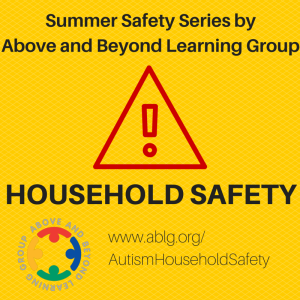
Now that kids are home from school… it’s time to do a household safety check!
Have you downloaded our FREE ebook, QuickStart Safety Guide for Individuals with Autism? It covers: Wandering and Elopement, Household Safety, and Community Safety. We’ve broken down these overwhelming areas for you.. just take one step at a time to create a safer environment for your learner!
One of the first areas that ABLG assesses during an intake is the safety of the household. We ask questions like, “Does your child know and demonstrate understanding of rules like ‘A stove is hot’ and ‘Knives are sharp’?”
Most commonly, children can recite the rules… but in the actual real-life situation, can’t always demonstrate his or her knowledge.
It’s important to take a two-fold approach to safety! First, prevent accidents by securing some blind spots in your home. Second, ask your home therapy team to prioritize teaching safety skills ~ we’ve created a handy checklist for you!
Secure your home
__Install deadbolts on all doors ~ out of your child’s reach!
__Install a home security system with a LOUD alert. Many alarm systems have quiet beeps that families quickly adjust to and barely hear.
__Install simple home-alert devices on windows and doors, such as those available from Radio Shack
__Install window guards
__Install fridge guards
__Install outlet covers ~ these are worth the investment for the ones that are extra tricky to remove! Children are smart ~ they figure out those cheap ones quickly.
__Be sure that big-screen TVs and furniture are secured to the walls with anchors ~ it only takes one wrong move to send a huge bookshelf toppling over onto a child!
__Post “STOP” signs on cabinets containing sharp or poisonous items. Your home-based team can help you teach your child to respond to the “STOP” signs.
__Install cabinet guards, too! Again, most children are smart enough to figure these out over time, so make sure you get the extra-tricky kind!
Individualized Programming
Taking steps to secure the home can buy us time to intervene
when a child is engaging in unsafe behavior. It’s also critical to
teach our kids to discriminate safe behavior from unsafe
behavior, and what to do when faced with danger. We often
promote implementation of programs such as:
_____The “STOP” Program. The child is taught to “stop” the
unsafe behavior, such as opening a cabinet or going outside,
when they see a sign, like a stop sign or photo of a caregiver.
Alternatively, sometimes a child is taught to go and get an adult
that is represented on the STOP sign before leaving the home.
_____Demonstrate Home Safety Rules. Knives are sharp, stoves are hot, chemicals
are poisonous… First, we teach children the discrimination
between “safe” and “unsafe” household items… then we teach them to demonstrate the knowledge! It’s not enough for kids to report the rules; they need to show they can follow the rules in real life!
_____Stranger Danger. Stranger Danger isn’t only a concern out in the community. Kids need to know who they can open the door for. Create a household policy, and ask your team to help you teach kids strangers from trusted relatives when the doorbell rings! Provide this study to your team so they can replicate it at home.
This post is part of our Summer Safety Series. Check out our post on preventing wandering, elopement, and drowning!
National Autism Association’s Big Red Safety Shop
http://nationalautismassociation.org/store
Autism Speaks Safe Signals Program
https://www.autismspeaks.org/family-services/autism-safety-project/in-home
Above and Beyond Learning Group’s Quick Start Safety Guidehttp://www.ablg.org
More Resources:

Leave a Reply